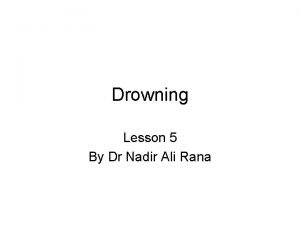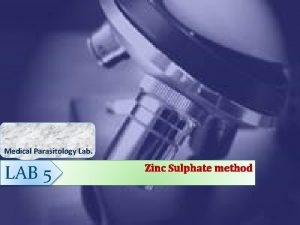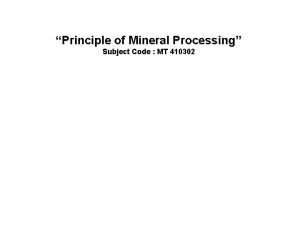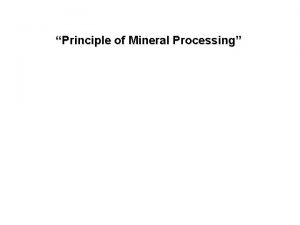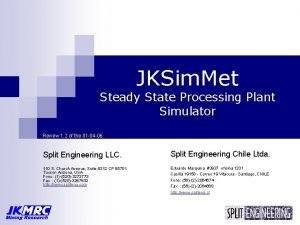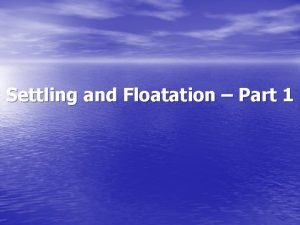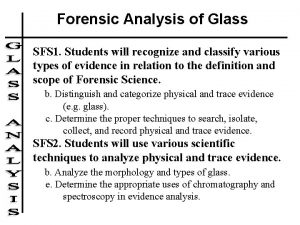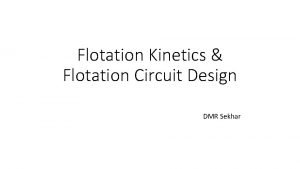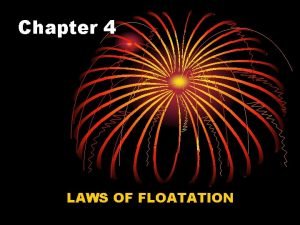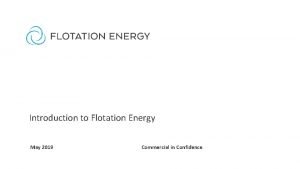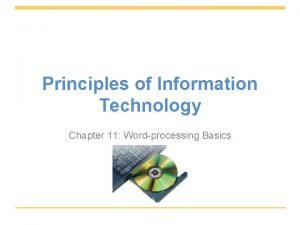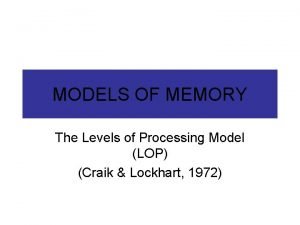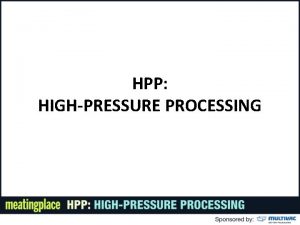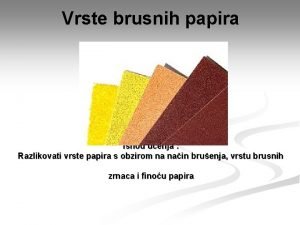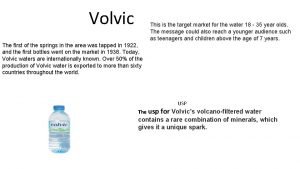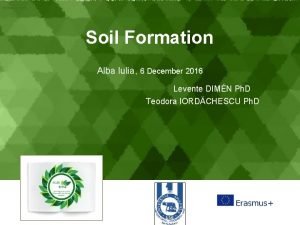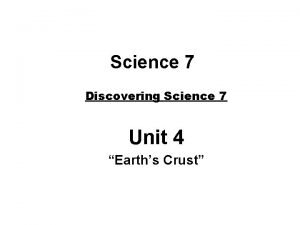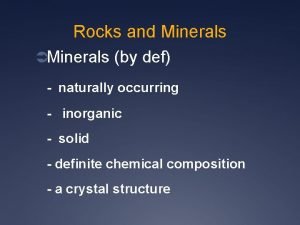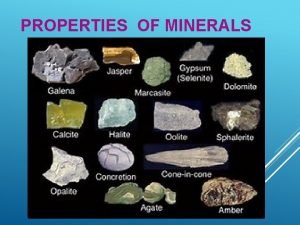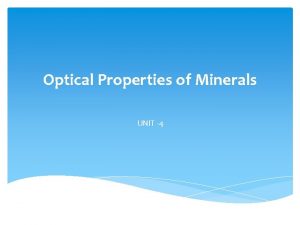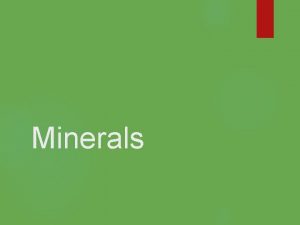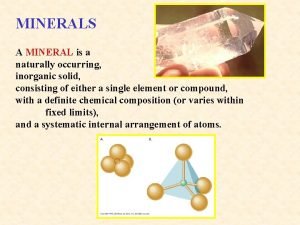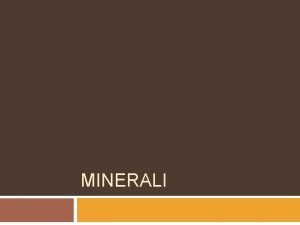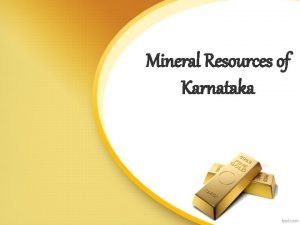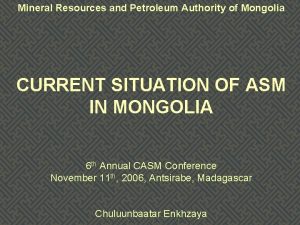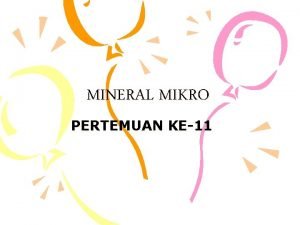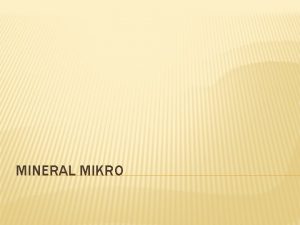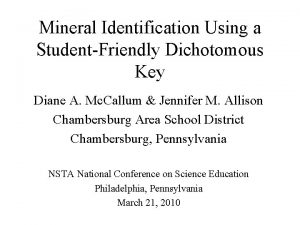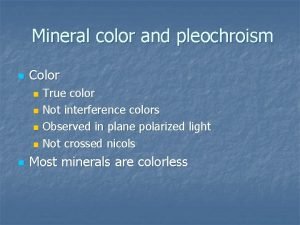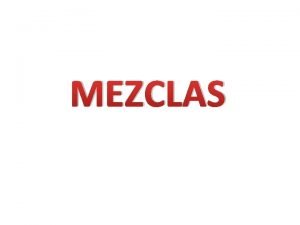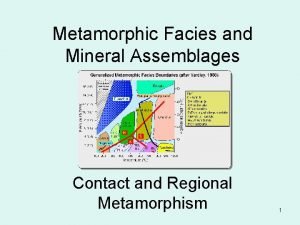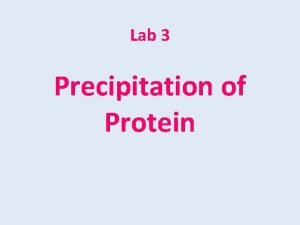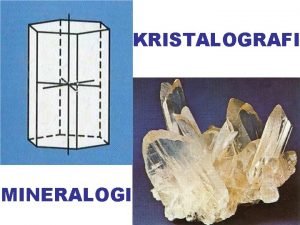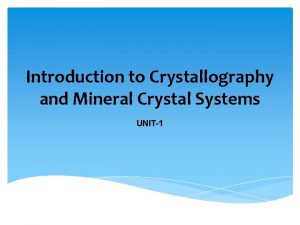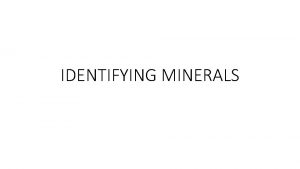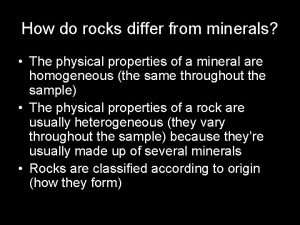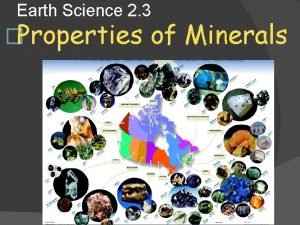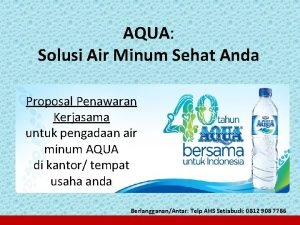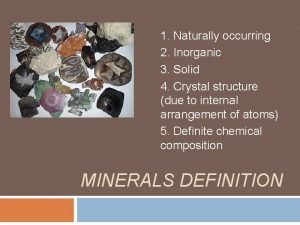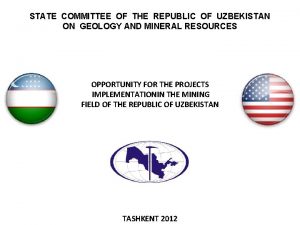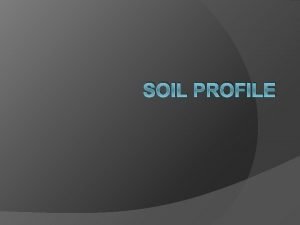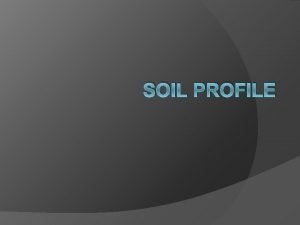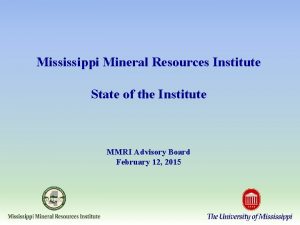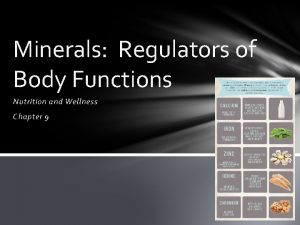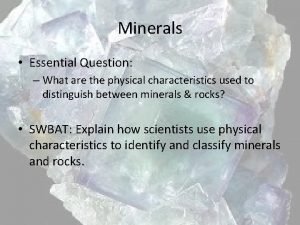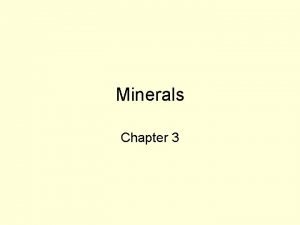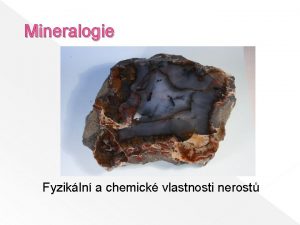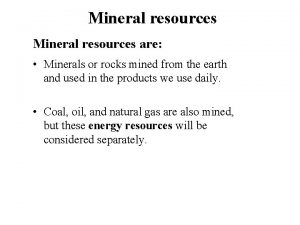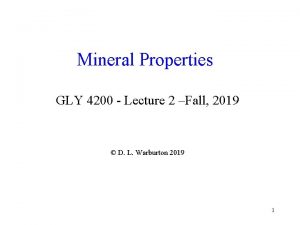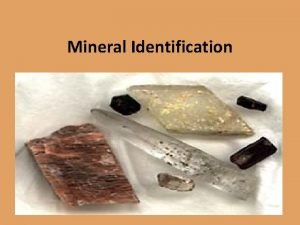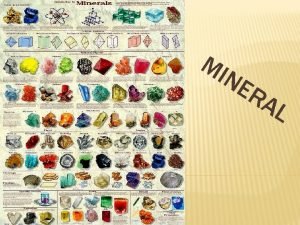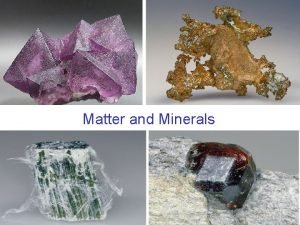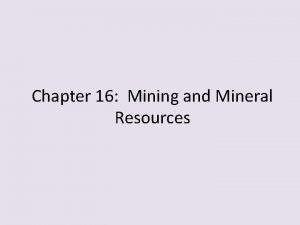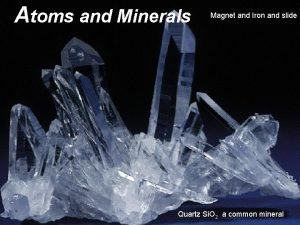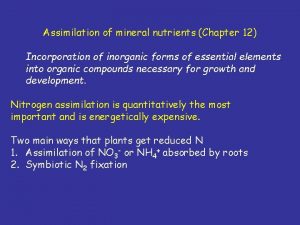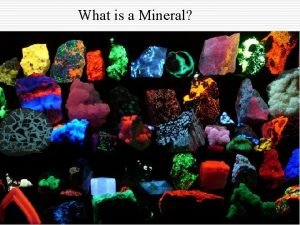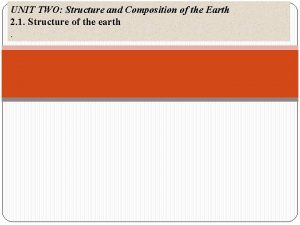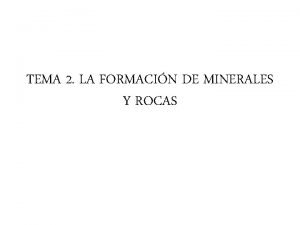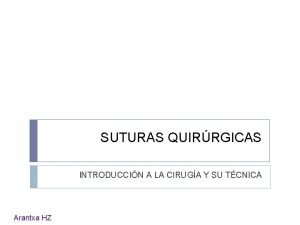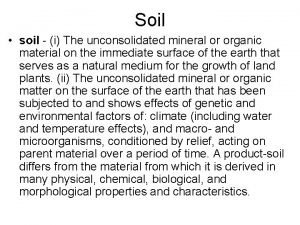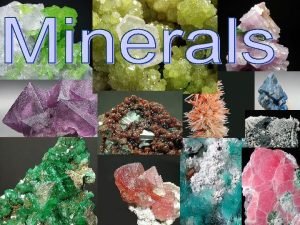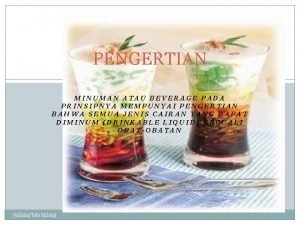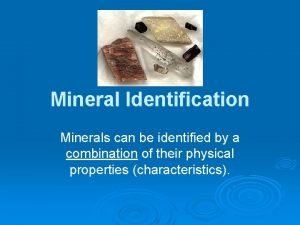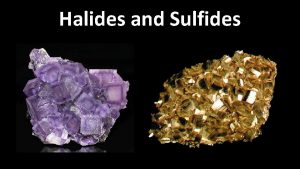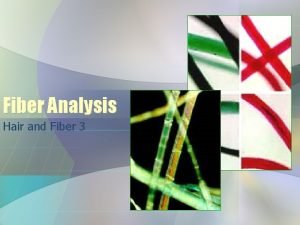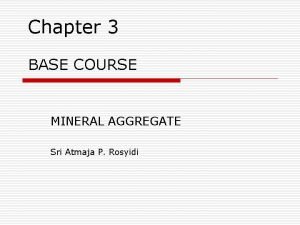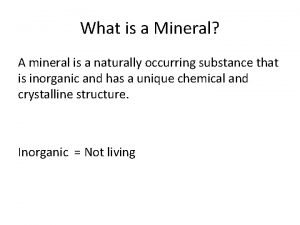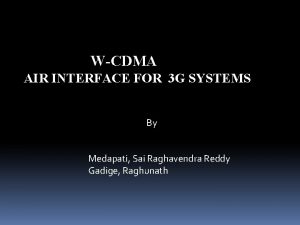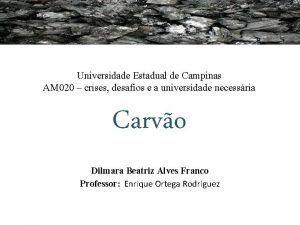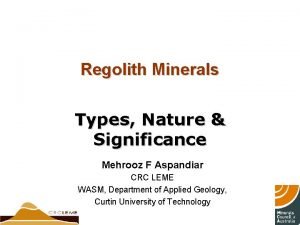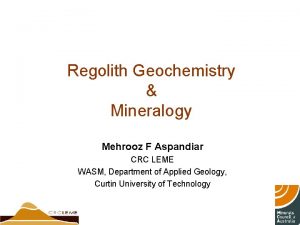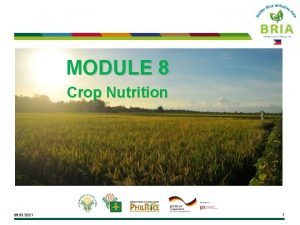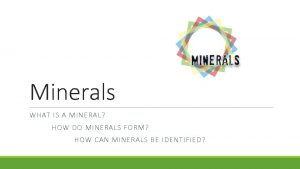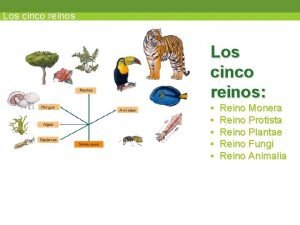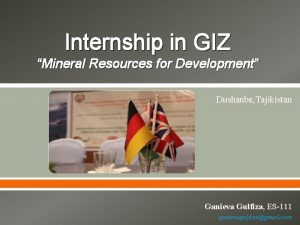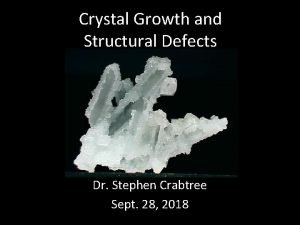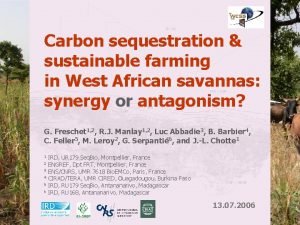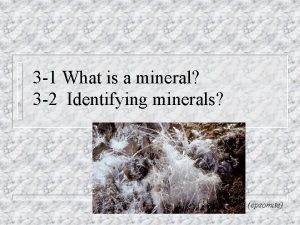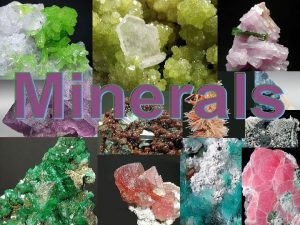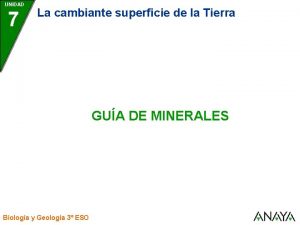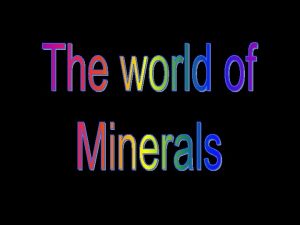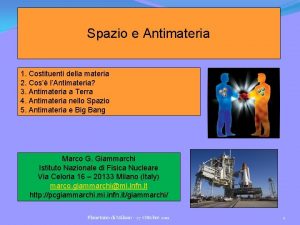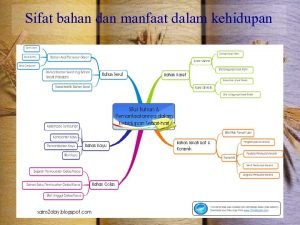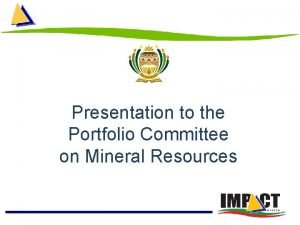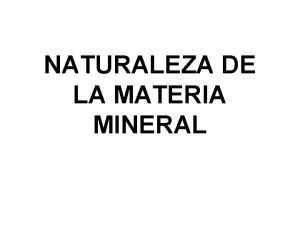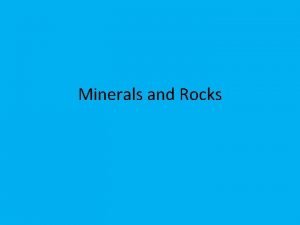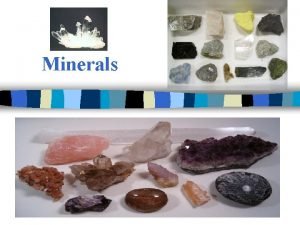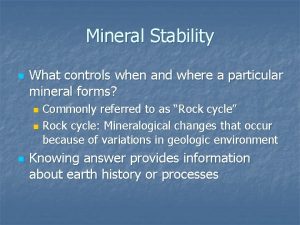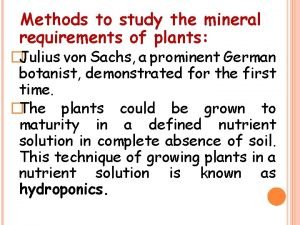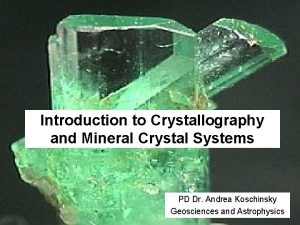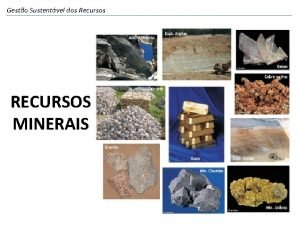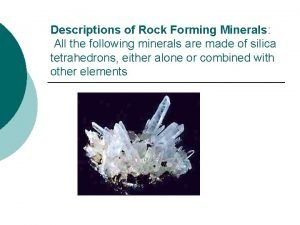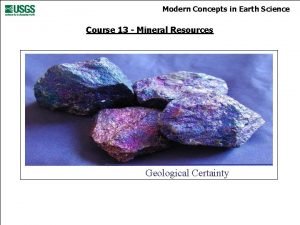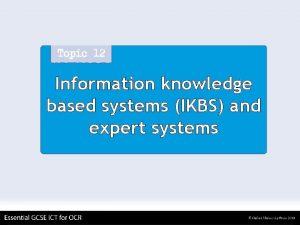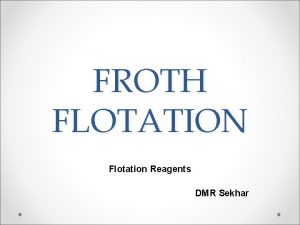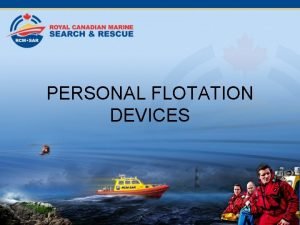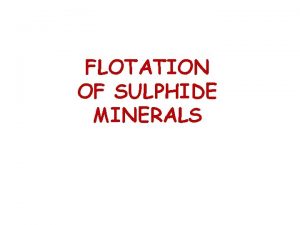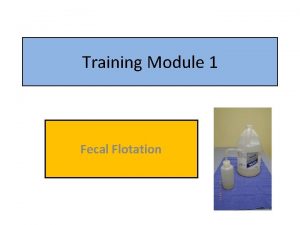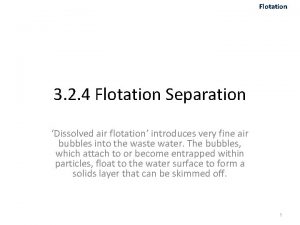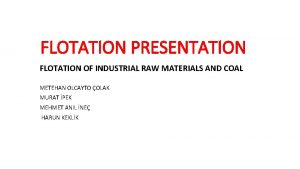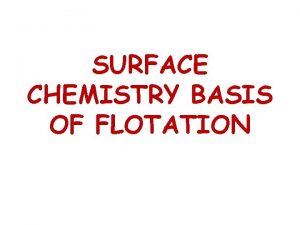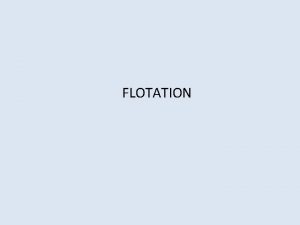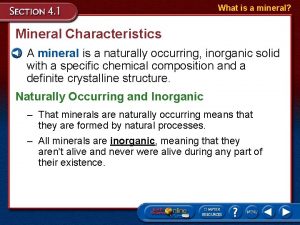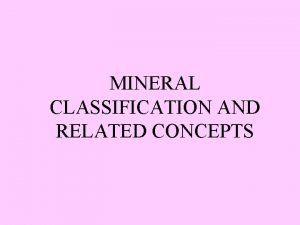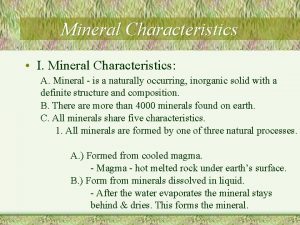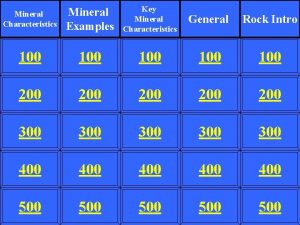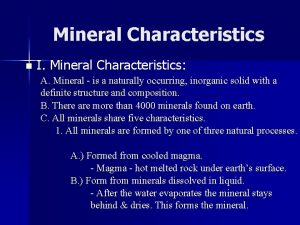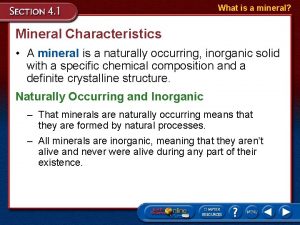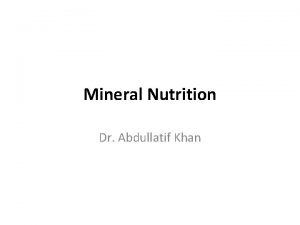Principle of Mineral Processing Chapter 4 Froth flotation





























































































































































- Slides: 157

“Principle of Mineral Processing”

Chapter 4 Froth flotation : principles, reagents, collectors, modifiers and frothers, process variables in floatation, Tailings disposal, Process integration and Study of flow sheet for important minerals.

Flotation 9/25/2021 3

Range for Particle Size for Wet Separation Techniques PHYSICAL PROPERTY WET SEPARATION METHODS Screens Cyclones Size, Density, Shape Centrifuge Sprial Table Size, Density Mozley Table Magnetic Susceptibility Magnetic Separator Wettability Selective Flocculation Surface Chemistry 1 10 Flotation 100 Microns 1000

Flotation • Process of separating fine particles of different minerals from each other by floating certain minerals at or on water surface • Mineral particles heavier than water maintained in suspension by action of surface tension forces • Separation affected by – some solids adhere to air / gas /oil bubble introduced in the pulp and other solids adhere to water • Wettable particles sink into water phase • Particle adhering to air float as froth due to lower sp. gr. 9/25/2021 5

Flotation • Floatability dependent on mineral surface and sp. Gravity • Surface properties modified during flotation • Mostly used for concentration of fines ( <150 microns) of sulphide minerals , oxide ores , non-metallic ores • Facts : -Most minerals adhere to water in preference to air -some minerals adhere to air due to inherent property -Hydrocarbons & paraffins adhere to air -All minerals can be made to adhere to air or water by use of suitable agent 9/25/2021 6

Types of Flotation • Froth Flotation - Based on the fact that hydrophilic particles are wetted by water whereas hydrophobic particles are wetted by air – air-solid aggregates are carried to the surface – forming a froth layer – Most common technique • Film Flotation -Ground ore particles sprinkled into water surface – water repellent ( unwettable) particles remain on surface while water avid ( wettable) particles pass into water 9/25/2021 7

Types of Flotation • Oil Flotation -Based on selsctive wetting of mineral particles by some oil such as Kerosene dispersed in water - particles of graphite covered with oil float on top • Combined Flotation –Gravitational method -when the lifting power of air bubble is inadequate , particle – bubble agglomeration technique is employed –e. g. sulphide particles having coarse grains forming particle bubble complex of reduced specific gravity to float 9/25/2021 8

Types of Flotation • Ion Flotation -This is a new flotation technique and differs from collection of particles by flotation -Process employed when ore is in aqueous solution as ions or colloidal suspension -Based on conversion to a product having hydrophobic sites which attach themselves to a bubble and collapse on reaching surface – resulting into a scum rather than froth -Ion flotation has great potential to treat leach solutions , dissolved minerals , sols & gels 9/25/2021 9

Froth Flotation • Most important & versatile mineral processing technique • Low grade & complex ore mining is economical now • Used to achieve specific separations from complex ores such as -sulphides of copper , lead , Zn , Ni , Pt and Gold –hosting mineral -oxides such as hematite , cassiterite , malachite , cerussite -non metallic ores such as fluorite , phosphates , fine coal 9/25/2021 10

Froth Flotation • It is a physico-chemical separation utilising the difference in surface properties of valuable minerals & unwanted gangue minerals • Theory of froth flotation is complex involving three phases – solid , water & froth with many sub processes & interactions and is not completely understood • Mineral being separated undergoes three mechanism : -Selective attachment to air bubble ( true flotation ) -Entrainment in water which passes through froth -Entrapment between particles in froth - aggregation 9/25/2021 11

Froth Flotation • The attachment of valuable minerals to air bubble is the most important mechanism by which majority of particles are recovered • Separation efficiency between valuable mineral and gangue is also dependent on degree of entrainment and physical entrapment • During froth flotation process , the agitator provides enough turbulence in the pulp phase to promote collision of particles and bubbles which result in attachment of valuable particles ( after reagent treatment ) to bubbles and transport to froth phase 9/25/2021 12

Froth Flotation • Applicable to relatively fine particles because if they are too large , the adhesion between the particles & the bubble will be less than the particle weight • When mineral is transferred to froth leaving the gangue in the pulp or tailing -Direct froth flotation • When gangue is transferred to froth leaving the mineral in the pulp or tailing -Reverse froth flotation • The function of froth phase is reduce the recovery of entrained material while retaining the attached valuable particle 9/25/2021 13

Froth Flotation 9/25/2021 14

Flotation 9/25/2021 15

Flotation 9/25/2021 16

Physical Chemistry of Flotation • The real surface property of minerals is the CHEMICAL & CRYSTALLOGRAPHIC capability to interact with organic ions Physical chemistry includes various aspects such as 1) Surface modification : -It is considered as rebalancing between hydrated complex ions & charged lattice points -If polar strength of water molecules aided by p. H is more than attraction binding of mineral ion into its crystal lattice , ion will hydrate and pass into aqueous phase. 9/25/2021 17

Physical Chemistry of Flotation • Mineral Particle surface not homogeneous due to various defects – It will have both hydration prone & water repellent charged points available • Surface of mineral must be clean to react with chemicals • If surface contaminated with oil , tightly adherent slimes , iron stains etc , remedial measures like dispersing agent / p. H control required for effective flotation treatment • Some minerals exhibit inherent or native floatability which is fundamental characteristic of crystal having no ions at the surface 9/25/2021 18

Physical Chemistry of Flotation 2) Surface Energy of particle • Adsorptive property of mineral are affected by crystal structure which result in different response to hetropolar surfactants • In a crystal lattice of mineral , energy difference between atoms at surface and inside body of lattice • Particles having high lattice energy ( Silica , Alumina ) more resistant to chemical change /activation by flotation. Na. Cl with low activation energy readily ionised and soluble in water 9/25/2021 19

Physical Chemistry of Flotation • However , the available reaction energy of surface atoms depends on neighbouring atoms as well as atom layers beneath them. As a result some energy of atoms unused – Free Surface Energy – Unsaturated bonds available • The magnitude of this energy ( for liquid it is surface tension) determines the nature & ability of mineral surface to react with water and reagents dissolved in it • The force determining the ability to attract external ions is the surface energy of a particle 9/25/2021 20

Physical Chemistry of Flotation 3) Surface Activation • In flotation , activation refers to causing of selective reaction on surface of mineral usually resulting in attraction into airwater interface • Due to activation – particles drawn into rising bubble – reagents used for this property –Activators • Activators and depressants (surfactants) usually consist of inorganic ions which affect the adsorptive power • Oxygen is adsorbed from water in preference to other gas 9/25/2021 21

Physical Chemistry of Flotation • Surfactant is fixed after adsorption of oxygen • p. H ( H-ions) promotes an attracting potential at the surface of each mineral • Maximum adsorption of collector molecules is found at the iso electric point of a mineral – point of zero charge on the surface – determined in relation to p. H value • Electric equilibrium is disturbed by transferring one type of ion ( +/-) to make surface charged – Ions of opposite charge do not escape the lattice now & ions present in the solution drawn nearer to surface to balance – Double Electric layer 9/25/2021 22

Flotation –Electrical Double Layer • All particles in the suspension exert mutual attraction force i. e. Van der Waals’ force which are effective only at a very close range • Normally , the adhesion due to these forces is prevented by the presence around each particle of an electrically charged atmosphere which generates repulsion forces between particle approaching each other • The electrical charges on the particle will be of same sign -for p. H > 4 , negative charge on the surface -for p. H < 4 , positively charged surface 9/25/2021 23

Flotation –Electrical Double Layer • Electrolytes having an opposite charge to the particles cause neutralisation when dispersed in the system , thus , allowing the particle to adhere as a result of Van der’s attractive force • Inorganic salts having cation such as Al(+++), Ca(++) –lime , Fe(+++) , H 2 SO 4 used for coagulation • Most pronounced coagulation occurs when particles have zero charge in relation to suspending medium i. e. ZETA potential equal to 0 existing at the electrical double layer at the surface of a particle. 9/25/2021 24

Flotation –Electrical Double Layer • The surface shown has –ve charge such that positive ions from solution will be attracted forming a bound layer of +ve Ions and a diffuse layer of these ions until concentration Bound layer - + + + Surface of particle - + + + + - Diffuse layer Electrical potential Zeta potential Plane of shear equilibrium is attained. 9/25/2021 25

Flotation –Electrical Double Layer • These layers ( B +D) of ions close to surface constitute Electrical Double Layer. • When a particle moves in the liquid , shear takes place between the bound layer ( moving with particle) and diffuse layer , potential at the shear plane – Zeta potential • The magnitude of Zeta potential depends on surface potential and concentration of counter –ion charge • In general , greater the counter –ion concentration , lower is the zeta potential 9/25/2021 26

Physical Chemistry of Flotation • There is electrokinetic potential difference between the inner & outer layer ions( more mobile ) is set up – Zeta Potential • With change in Zeta potential ( magnitude & sign ) , reagent ions penetrate to the inner layer and adsorption to mineral surface is affected –Xanthates affect the potential of conducting minerals • Flotation property of minerals is tested in terms of surface hydration -the attraction of water dipoles to the surface lattice points is due to free atomic / molecular force - hydration influences solubility of minerals 9/25/2021 27

Physical Chemistry of Flotation 4) Reaction between Water & Mineral • Wetting of mineral surface – adsorption of water ions and molecules on mineral –water interface • The hydrated skins are formed when the bond energy between water dipoles and the mineral surface exceeds the bond strength between water dipole themselves • Water –avid ( Hydrophilic) mineral surface has unsaturated ionic or atomic bonds predominant • Water-repellent – Unsaturated molecular bonds 9/25/2021 28

Physical Chemistry of Flotation • Ionic bond in minerals having oxygen bearing anion is stronger than in case of sulphides – as a result water dipoles on sulphide surface less firmly attched • Mineral surface may also react with gases like Oxygen – action of oxygen is to render mineral water repellent property 5)Solubility of mineral in water • The dissolution of mineral in water – result of reaction between water & mineral particles • Direct reaction of water molecules on mineral surface in a 9/25/2021 29

Physical Chemistry of Flotation pulp may lead to breakdown of their crystal lattice resulting into separate hydrated ions which forms ionic solution • On dissolution of mineral in water , crystal lattice energy of the mineral is absorbed by solution and at the same time ion hydration energy is given off. The difference between the two energy is the heat of solution of mineral in water. • Minerals dissolve in water when ion hydration energy is more than the crystal lattice energy • Hydration energy increases slower than lattice energy with increase in valency –solubility reduced with valency increase 9/25/2021 30

Physical Chemistry of Flotation • Hence , sulphides & oxides of bivalent metals are much less soluble in water than corresponding mono valent metal compounds 6) Reaction between sulphide & dissolved oxygen in water • It is very important in flotation process as oxygen may cause changes in composition of mineral surface by chemical action • In presence of water , action of oxygen on sulphide minerals causes oxidation into sulphates which is more soluble • Smaller particles of minerals more prone to oxidation 9/25/2021 31

Physical Chemistry of Flotation • Presence of CO 2 dissolved in water also affect composition of mineral surface – carbonates can form sulphates – p. H change 7) Reaction between mineral surface & dissolved components • These reactions may be considered as the adsorption of electrolytes dissolved in water on the solid –liquid interface • These electrolytes may be either added to the pulp or formed in it due to mineral going into the solution • There are different types of adsorption on the surface 9/25/2021 32

Physical Chemistry of Flotation a) Molecular Adsorption • Also known as non-polar adsorption in which adsorbent mineral particle) takes up equal amount of cations & anions from solution – State of electrical neutrality on the phase boundry is unchanged ( • Weak electrolyte adsorbed on the solid phase as molecule due to poor dissociation • Mineral acids ( H-ions ) are adsorbed more easily than their alkaline salt 9/25/2021 33

Physical Chemistry of Flotation b) Ionic Adsorption • Also known as polar adsorption in which ions of same sign are transferred between solution & solid phase resulting in unchanged surface charge c) Specific Adsorption • It is selective uptake of anions or cations from solution by solid phase resulting into formation of difference in potential on the interface leading to double electric layer formation • The ions of similar dimension are adsorbed at mineral phase 9/25/2021 34

Physical Chemistry of Flotation • The adsorption of potential determining ions common to mineral crystal lattice • A crystal immersed in a solution containing ions similar to its own , will actively adsorb one or another of these ions resulting in an increase of its electro kinetic potential • For example – - Ag. I crystal will selectively adsorb Ag ions from Ag. NO 3 solution and Iodide ions from KI solution 9/25/2021 35

Physical Chemistry of Flotation-Wettability 9/25/2021 36

Physical Chemistry of Flotation -Wettability • The forces tending to separate a particle and a bubble exist • The tensile forces lead to the development of an angle between the mineral surface and bubble surface • At equilibrium , Y s/a = Y s/w + Y w/a cos Ѳ where Y is the surface energies are between different surfaces & Ѳ is the contact angle • The force required to break the particle-bubble interface is called the ‘work of adhesion – Ws/a’ and is equal to the work required to separate the solid-air interface and produce separate air-water and solid-water interfaces 9/25/2021 37

Physical Chemistry of Flotation -Wettability • Ws/a = Y w/a + Y s/w –Y s/a combining both the equations , we get Ws/a =Yw/a ( 1 -cos Ѳ) So , greater the contact angle , greater the work of adhesion between particle and bubble , hence more resilient to disruption. • Hydrophobicity of mineral increases with contact angle and are called Aerophilic ( floatable) • Most minerals are not water –repellent in their natural state , hence reagents are required 9/25/2021 38

Physical Chemistry of Flotation -Wettability Free Energy Change for Flotation (Young-Laplace Equation) g. LG GAS LIQUID g. SL Since DGFLOT = g. SG - g. SL - g. LG g. SG SOLID g. LG Cos q = g. SG - g. SL DGFLOT = g. LG (Cos q – 1) Where: g. SG, g. SL, g. LG = Interfacial Tensions • Flotation Spontaneous for Finite q

Physical Chemistry of Flotation -Wettability • Water droplet 9/25/2021 40

Physical Chemistry of Flotation • Surface property of mineral dependent on capability of interacting with particular organic ions resulting in thin layer ( monomolecular layer ) attached to mineral surface • This condition results in lower work of adhesion ( high surface tension ) and recognised as Wettability - measured in terms of contact angle at an interaction with air-water interface • Contact angle ( zero - fully wettable ), 180 deg for unwettable • Wetting -adsorption of water ions & molecules on mineral water interface 9/25/2021 41

Types of Mineral – Surface Property • All minerals are classified into POLAR or NON POLAR types according to their surface characteristics • Non polar mineral surface -characterised by molecular bond forces –weak covalent bond -mineral surfaces do not attach readily to water dipoles , hence hydrophobic • e. g. Graphite, Sulphur , Molybdenite , Diamond , Coal • Contact angle between 60 to 90 deg , natural floatables 9/25/2021 42

Types of Mineral – Surface Property • Polar Mineral surface -Minerals with strong ionic surface bonding -Exhibit high free surface energy at polar surface - Polar surface react strongly with water molecules – Hydrophilic type • Polar minerals subdivided based on magnitude of polarity Gp 1 -Galena , covellite , Chalcopyrite, Native Au, Ag weakly polar due to covalent bonding 9/25/2021 43

Types of Mineral • Gp 2 -Baryte , Gypsum • Gp 3 -Malchite , Azurite – rendered hydrophobic by sulphadisation of mineral surface in alkaline media • Gp 4 – Hematite , Magnetite , Illmenite • Gp 5 – Quartz, Zircon , Feldspar • In general , degree of polarity increases from sulphide minerals through sulphates to carbonates, Halides , phosphates , Oxides –Hydroxides and finally silicates & quartz 9/25/2021 44

Physical Chemistry of Flotation • In general, chemical groups or surfaces with any charge (ionic, dipole) are hydrophilic and will bond with water molecules but those with neutral (zero charge) are hydrophobic and will be repelled by water. • Collectors have a polar (charged) head group and a nonpolar (neutral) group or chain. They adsorb on mineral surfaces with their polar group attached to the mineral surface and the non-polar hydrophobic group exposed to the aqueous solution. 9/25/2021 45

Physical Chemistry of Flotation • Water is strongly and extensively hydrogen-bonded to other water molecules. The hydrophobic group disrupts some of this hydrogen bonding causing the mineral-collector to be repelled by water and attached to bubbles. • This repulsion by water also induces aggregation of hydrophobic surfaces • In some cases activators, which are meant to adsorb on specific minerals, are added to enhance the attraction between the polar group and the mineral surface 9/25/2021 46

Covalent Bonds • The simplest covalent bond is that in H 2 – the single electrons from each atom combine to form an electron pair – the shared pair functions in two ways simultaneously; it is shared by the two atoms and fills the valence shell of each atom • The number of shared pairs – one shared pair forms a single bond – two shared pairs form a double bond – three shared pairs form a triple bond

Polar and Nonpolar Covalent Bonds • Although all covalent bonds involve sharing of electrons, they differ widely in the degree of sharing • We divide covalent bonds into – nonpolar covalent bonds – polar covalent bonds

Polar Covalent Bonds • Bond dipole moment ( ): – a measure of the polarity of a covalent bond – the product of the charge on either atom of a polar bond times the distance between the nuclei – Table 1. 7 shows average bond dipole moments of selected covalent bonds

Polar and Nonpolar Molecules • To determine if a molecule is polar, we need to determine – if the molecule has polar bonds – the arrangement of these bonds in space • Molecular dipole moment ( ): the vector sum of the individual bond dipole moments in a molecule – reported in debyes (D)

Polar and Nonpolar Molecules • these molecules have polar bonds, but each has a zero dipole moment

Polar and Nonpolar Molecules • these molecules have polar bonds and are polar molecules

Polar and Nonpolar Covalent Bonds – an example of a polar covalent bond is that of H-Cl – the difference in electronegativity between Cl and H is 3. 0 - 2. 1 = 0. 9 – we show polarity by using the symbols d+ and d-, or by using an arrow with the arrowhead pointing toward the negative end a plus sign on the tail of the arrow at the positive end

Flotation Variables • Effect of size & shape of minerals -strong water repellent & low sp. gr. minerals can be floated in bigger size ( coal 1. 5 to 2 mm). Most common size 0. 1 to 0. 02 mm for flotation , flaky minerals easily floated • Mineral surface & crystal lattice -Various faces of crystal with different surface energy levels absorb water or reagents to different extents -Adsorption affected by presence of lattice defects , cracks -Isomorphism ( mutual substitution of atoms /ions in lattice forming solid solution) impurities during mineral formation vary a lot affecting reaction of reagent 9/25/2021 54

Flotation Variables • Effect of pulp density & temperature -affecting aeration & floatability , higher temp. improves flotation but reduces selectivity • Effect of Process water composition -Mill / process water from river has Na, K, Ca, H, Cl, SO 4 ions affecting p. H alongwith other impurities oil , grease, minerals -Ions & impurities react chemically with reagents -Effect more pronounced in non-sulphide minerals ( oxides, silicates) with soaps & fatty acids • Effect of reagent feeds – quantity , sequence & quality Sequence – regulator ( p. H), depressents, collector, frother 9/25/2021 55

Flotation Reagents • For selective & efficient separation by altering the surface properties of minerals to either make water avid or water repellent • Common reagents Organic , inorganic compounds, acids, alkalis, salts • Reagents – Collectors , Frothers, Modifiers ( regulators) based on their function in flotation • Adsorption ( chemical or physical ) -Reagents attach to the surface of either air bubble or mineral particles after interaction of electrical forces between the adsorbent & the reagent , accompanied by decrease in free energy of system & heat release 9/25/2021 56

Flotation Reagents -Mechanism • Physical adsorption – adsorbed substance & mineral lattice , two different systems –bond with crystal lattice results due to forces of inter molecular attraction –weak bond , even distribution • Chemical adsorption – transition of electrons from adsorbed atom to lattice or vice versa – strong bond, highly selective in action , first attached to most active position • Attachment of reagent to Air bubble – surface active substance introduced concentrate at air-water interface by physical adsorption giving rise to hetero polar molecular structures having non polar hydrocarbon group & polar group ( carboxyl & hydroxyl). Water dipoles work with polar group. 9/25/2021 57

Flotation Reagents -Non polar hydrocarbon group does not react and ejected into air -Activity between polar groups of surface active molecules & water dipoles result into hydration • Attachment of reagents in a double electric layer ( anions & cations from solution)–physical adsorption of reagent in outer skin and chemical adsorption in the inner skin • Attachment of reagent to minerals as surface compounds – atoms or ions in the mineral crystal lattice are the links with ions or atoms getting attached to the lattice – surface compound formation is chemical adsorption and highly selective – Ion exchange adsorption -common in flotation 9/25/2021 58

Flotation Reagents • The mineral particles can only attach to air bubbles if they are to some extent water-repellent or HYDROPHOBIC • Having reached the surface of mineral particle , air bubbles can continue support if mineral particle can form stable froth , otherwise they will burst • To achieve these conditions , numerous types of chemical compounds known as Flotation Reagents are used. • The activity of mineral surface in relation to flotation reagents in water depends on the forces which operate on particle surface 9/25/2021 59

Flotation Reagents • ACTIVATORS: enhance the flotation by collectors that will not float in their absence e. g. calcium activated flotation of Quartz using oleate • DEPRESSANTS: prevent the adsorption of collectors and thereby retard flotation (also by masking the nonpolar part of the adsorbed collector) e. g. starch, polymers, dextrin • DEACTIVATORS: prevent activation by forming an inert stable specie with the activator molecules • FROTHERS: induce the desired froth stability during flotation

Flotation Reagents -Collectors • Also called promotors – organic substances – act selectively on surface of minerals – form thin coating by adsorption /adhesion to render them water repellent / air adherent • Features – complex molecular composition , asymmetrical structure , consisting of polar and non polar groups • Non polar part – hydrocarbon ( Cn. Hm)or chain , no reaction with water dipoles due to covalent atoms presence – water repellent properties • Polar group – during flotation , adsorbed on mineral surface while non polar is oriented outwards which makes mineral water repellent 9/25/2021 61

Flotation Reagents -Collectors • Classification based on ability to dissociate into ions in aqueous solution & activity of anion & cation taking part in reaction on mineral surface • Ionising collectors – compounds which dissociate into ions in water -Anion collector –Anion of these compounds render the mineral water repellent while cations do not take part in reagent /mineral reactions , most widely used , strong attachement e. g Xanthates -Cation Collectors – water repellent ions , anions of the collectors are halide /hydroxyl which do not take part in reaction , weakly attached , e. g Amines & ammonium salt 9/25/2021 62

Flotation Reagents -Collectors • Sodium ethyl xanhate has anion as hydrocarbon non polar radical and a connected polar group. Although the cation ( Na or K) plays no part in the reaction leading to mineral hydrophobicity, but sodium form of alkyle xanthates Collectors can adsorb on the substrate due to: - Hydrogen bonding - Electrostatic interaction - Chemical bonding - Hydrophobic bonding The nonpolar end should orient towards the bulk solution 9/25/2021 63

Flotation Reagents -Collectors • Collector adsorption on mineral surface Non polar grp Polar group Mineral • Structure of sodium Oleate- collector – hydrocarbon as non polar radical part of molecule H H H----C---O---C H H Non Polar Na Polar Anion 9/25/2021 S S Cation 64

Flotation Reagents -Collectors • Non polar & other collectors -Insoluble in water and do not dissociate into ions -covalent bonds between atoms , do not react with water dipoles -Render mineral water –repellent by covering its surface with a thin film -These are hydrocarbon liquids ( kerosene, diesel etc) Choice of collector for a specific process – determined by experience & expeiments 9/25/2021 65

Flotation Reagents -Frothers • Reagents added to produce stable froth to hold mineral particle until it is removed from cell • These are surfactants of low solubility & low surface tension which increases the life of bubble • Frothes are hetropolar surface active substances which are adsorbed at air-water interface to its surface activity • After mineral particles surface rendered water repellent , presence of frothers keep air-bubble dispersed and increase stability of flotation froth • Frother adsorption layer increases bubble resistance to external forces , reduce bubble movement for better reaction 9/25/2021 66

Flotation Reagents -Frothers • Factors affecting the action of frothers : -With low frother concentration , dispersion of bubble effective -Reagents having collector as well as frother properties make flotation difficult – Frothers with no collectors properties preferred -Proportion of frother & collector -Temperature effects no. of water dipoles combining the polar group Types of Frothers : -Pine oil ( sulphide mineral), Eucalyptus oil(Oxide Mineral) 9/25/2021 67

Flotation Reagents -Modifiers • Known as regulators or conditioners • For intensifying the specific action of collector on mineral surface ie to decrease or increase water repellent action • In presence of regulators , collector activates specific mineral required to pass in the froth • Mechanism : -Net effect in terms of wetting ( surface hydration ) and drying out ( air avidity for attachment of particles to airbubble) forces on mineral particles 9/25/2021 68

Flotation Reagents -Modifiers • Replacement of gas by liquid ( or vice versa) on solid surface – net decrease in interfacial free energy of system • Modifiers act on surface of specific mineral and change its chemical composition for better interaction of collector & mineral e. g. Cu. SO 4 reacting with Zn. S to form Cu. S on the surface of sphalerite and thus attachment of xanthate on Zn. S increases • These can create adverse condition by detaching collector from mineral surface leading to poor flotation ( depression effect) e. g Na 2 S leads to detachment of xanthate from surface of galena and other non ferrous sulphide 9/25/2021 69

Flotation Reagents -Modifiers • Direct effect on stability of hydrated layer near mineral surface altering its floatability e. G K 2 Cr 2 O 7 gets adsorbed on galena surface which are free from collector and thus hydrate decreasing the floatability Types of modifiers : Variety of organic & inorganic chemicals –salts, acids, alkalis, elctrolytes • Activators –generally in organic compounds , change in chemical composition of mineral surface layer – exchange adsorption between activator ions & mineral ions 9/25/2021 70

Flotation Reagents -Modifiers -Reduce surface hydration –increase amount of collector , ions of collector & activator are opposite e. g Cu. SO 4 for sphalerite, pyrite, quartz • Depressors –supressors opposite effect of activators e. G Na 2 S & water soluble sulphides for sulphide & oxide minerals , Cyanides for copper & Zn minerals • p. H regulators –flotation is effected by p. H as H+ and OHalter the mineral surface hydration due to their adsorption on mineral surface – different minerals have different critical p. H 9/25/2021 71

Flotation Reagents -Modifiers -Acid media ( p. H <7) for oxide mineral and alkaline media ( p. H >7) for sulphide minerals e. g. Na 2 CO 3, Na. OH, H 2 SO 4, HCl • Dispersing agent -to disperse the fines ( masking slimes) from mineral surface e. g. Sodium Silicate • Wetting Agents- To increase hydration and reduce floatability, proper wetting of gangue material – e. g. Sodium silicate , aerosol • Resurfacing agents – plate / resurface selected mineral by promoting the adsorption of hydrophobic hydro carbon group to preferred lattice points 9/25/2021 72

Flotation Practice • Basic steps in Flotation Process – Pulp preparation , Conditioning , aeration to obtain froth • Pulp preparation -Sizing -correct wet grinding to suitably floatable and liberated size ( <300 microns), coal ( 1 mm) being light , metal sulphide ( 200 -300 microns) -Pulp density – Thick pulp is preferred for stabilised froth during roughing flotation & dilute pulp in cleaning operation e. g. Chalcopyrite , Galena – Roughing operation at 30 -50% pulp density carried out while cleaning is done at 30 -8% pulp density 9/25/2021 73

Flotation Practice • Density of pulp plays an important role in flotation • It depends on mineral density & particle size • Upto a certain range of pulp density , less reagent & less stirring power required to keep the particle suspended • A thick pulp is preferred for stabilised froth • The working principle of flotation is to carry out roughing flotation in thick pulp and cleaning operation in dilute pulp to get high concentrate 9/25/2021 74

Flotation Practice The operation grinding and reconcentration can be repeated as many times as requiredfor maximum recovery. 9/25/2021 75

Flotation Practice • Conditioning is an operation in which pulp is continuously contacted for an optimum time with appropriate reagents at different stages to provide conditioned pulp giving the best results in flotation • Various functions carried out during conditioning -Slime coatings formed on mineral surface should be dispersed -Compounds in the pulp preventing flotation of desired mineral should be rendered ineffective -Activation of desired minerals 9/25/2021 76

Flotation Practice • Creation of conditions favourable for selective coating by collector on desired minerals • Closure of porus surface to minimise consumption of collector • Passivation of ions undesirable in the reaction • Resurfacing of non –floating or weakly –floating minerals desired in the froth • Finally the stabilisation of correctly mineral loaded bubbles by adding frother 9/25/2021 77

Flotation Practice • Conditioning efficiency depends on –complete mixing & dispersion of reagents through out the pulp , time of contact • The conditioning steps , concentration , amount of reagents and time are worked out in laboratory and applied in the plant. • Steps during conditioning 1)To depress the slimes since they adsorb expensive reagents , contaminate froths, give problem in settling of pulp -Preventive method - either slime removal before grinding or collector is added in the grinding circuit before slime coating 9/25/2021 78

Flotation Practice • Next step is to add required amount of reagent with proper mixing – Readily soluble reagents like soda ash disperse quickly • In treating sulphide ores , lime can be added as a slurry to the grinding circuit to produce required p. H • Relatively insoluble oils should be throroughly mixed • When there is chance of reaction of reagents with each other , instead of with minerals , reagents are used in successive steps 9/25/2021 79

Flotation Practice • For example -Activation of sphalerite by Cu. SO 4 should be completed before pulp is transferred to Xanthate ( (C 2 H 5 OCS 2 Na –sod ethyl Xanthate) conditioning tank -Otherwise reaction between copper & xanthate will result into an ineffective reagent • Since action of collector mainly depends on p. H of pulp but further specific conditions may be required before addition of collector – in order to increase difference between aerophilic and hydrophobic mineral surfaces 9/25/2021 80

Flotation Practice • Aeration -Conditioned pulp is agitated in flotation machine of suitable size & design , air admitted forms bubbles which collect mineral particles , mineralised bubbles collect as froth on top -The froth can be discharged into launder with scraper -In plant practice, a series of flotation cells ( 10 -12 nos. ) employed where pulp is continuously pumped from one cell to next for repeated treatment -The pulp discharging from the last cell is barren and can be discarded 9/25/2021 81

Flotation Practice • Extent of aeration depends on size , number and even distribution of air-bubbles in the pulp • Pulp aeration determines flotation machine output , grades of product and the reagent consumption • In mechanical type cells - bubble size 1 mm dia generated – frother is needed • In pneumatic type cells - bubble size 2. 5 -4 mm dia • The amount of air-bubbles in the pulp is proportional to air entering the flotation cell 9/25/2021 82

Flotation Practice Amount of air bubbles V (%) = 100 * t*Qa/Qb t=time spent by bubble in the pulp Qa= air flow in m 3/sec Qb= capacity of chamber in m 3 • The air must remain in the pulp for long time which can be achieved by -effective air dispersion -sufficient pulp layer thickness and turbulent motion • The formation of small bubbles is intensified by addition of frother 9/25/2021 83

Flotation Machines • Flotation machines or cells – flotation process carried out • Important Features -Aeration of pulp should be complete without letting too large bubbles -Solid should be distributed evenly without settling -Machine should work continuously -Removal of mineralised froth ( float) and tailings (sink) by separate channels -Periodic discharge of accumulated undesired material 9/25/2021 84

Types of Flotation Machines • Classification based on - Pulp flow - Method of pulp aeration • Machines based Pulp flow Trough type – Feed one end , tailings other end , froth flows over trough sides into channels Through –flow machines- divided into compartments – partition makes compartment open at top & bottom open , pulp level same Chamber type – separate chambers – different pulp level 9/25/2021 85

Types of Flotation Machines • Machines based on method of aeration -Mechanical type ( self aerating & mechanically agitated ) – consists of mixing chamber , impeller which draws in air , flotation tank in which bubbled pulp in injected e. g. Denver cell , Massco, Knapp -Pneumatic type flotation machines –air is blown to aerate as well as agitate the pulp , compressed air from bottom , feed from one end and tailing exits at the other end , concentrate ( as froth) overflows into launder 9/25/2021 86

Denver Flotation Cell • Machine should ensure -aeration of pulp to produce bubble -distribution of solids -removal of mineralised froth ( float) and tailings(sink) -continuous operation -pulp level and height of froth controllable 9/25/2021 87

Column Flotation Cell • This is simplest pneumatic type of flotation machine with minimum floor space & maintenance , air admitted through distributer • Suitable for dilute pulp mixing Advantages : -min gangue entrainment in froth -more bubble residence time -improved selectivity -Energy efficient Easy operation control 9/25/2021 88

Flotation System 9/25/2021 89

Flotation System 9/25/2021 90

Coal Flotation Scheme 9/25/2021 91

Flotation Schemes • Generally not possible to obtain high grade concentrate in one single stage • As minerals to be separated have identical properties , more than one product needed , separation not complete in complex ores • Different schemes based on flotation properties of ore , grade of concentrate required, economics of the process • Flotation scheme based on number of stages • Scheme based on number of flotation cycles • Flotation scheme based on number of products 9/25/2021 92

Flotation Practices • Recovery of same mineral from different ore bodies require different conditions of flotation due to small difference in crystal structure & chemical constituents of minerals affect the properties of mineral to be recovered. • Different schemes for specific ore and not to the mineral • Various steps in flotation : -Grinding of ore in water ( 200 micron ) -Dilution of pulp to required 25 -45 % pulp density - Addition of small quantity of reagents to modify the surface 9/25/2021 93

Flotation Practices -Addition of collector in optimum amounts -Addition of frother to stabilise the froth -Aeration of pulp in a suitable flotation cell -Removal of mineral –bearing froth from aerated pulp • Objectives of flotation -flotation of one or more mineral – copper concentrate -Depression of one /more gangue –for cleaning bulk conc. 9/25/2021 94

Flotation Practices • Flotation of sulphides -excellent flotation properties sequence- selective ( most water repellent mineral removal first) OR collective-selective flotation ( valuable minerals separated into froth and then separated) scheme employed -Xanthates as collector, Pine oil as frother • Flotation of Oxidised & Mixed Non Ferrous ores -Carbonates , sulphates , hydrates of Cu, Zn , Pb -Flotation consists of reaction of Na 2 S or (NH 4)2 S followed by flotation with collectors & frothers used for sulphides 9/25/2021 95

Tailings Disposal • The disposal of mill tailings is a major environmental problem with the increase in processing of low-grade deposits • Apart from visual effect on the landscape of tailing disposal , major ecological effect is usually water pollution contaminants like heavy metals , reagents , sulphur compounds • Waste must be disposed of in both an environmentally acceptable and economically viable manner • Nature of tailings varies widely & transported as dry material or slurry 9/25/2021 96

Tailings Disposal -Methods • Discharge of tailings into rivers & streams • Dumping of coarse dewatered tailings on to a land • Reprocessing to recover values or use them as product • Filling of mined –out areas by coarse mill tailings in underground mines - Back fill methods not applied for large quantitiy • For operation close to sea , submarine tailing disposal – can affect the deep sea ecosystem 9/25/2021 97

Tailings Disposal -Methods • Tailings Dams – economically advantageous but impose limits on site selection • Type of tailings embankment depends on water clarificatin , tailings properties & stability , foundation , environmental conditions • Tailing dams may be built across river valleys or multi-sided dam walls of valley • On flat or gently sloping ground , ponds are built with walls on all sides 9/25/2021 98

Tailings Disposal -Methods • Most serious problem associated with the disposal of tailings is the release of polluted water • Main effects of pollution due to effluent p. H , heavy metals ( Cu, Pb, Zn –lethal to fish life ) , chemical reagents • Tailings are often treated with lime to neutralise acids & precipitate heavy metals as insoluble hydroxides • Important factor for pollution control – Removal of surplus water from dam to avoid dam failures • Recycling of decant water in mill -interference in flotation – water treatment 9/25/2021 99

Flowsheet for Mineral beneficiation 9/25/2021 100

Flowsheet – Bauxite Refining 9/25/2021 101

Flowsheet – Bauxite Refining 9/25/2021 102

Gold Extraction at Kolar Gold fields 9/25/2021 103

Gold Extraction at Kolar Gold fields 9/25/2021 104

Gold Extraction in India • PACHUCA tanks are air-agitated slurry reactors used as leaching vessels for the extraction of nonferrous metals like uranium, gold, zinc, and copper. These tanks are operated with slurries containing 50 to 60 wt pct solids. 9/25/2021 105

Magnetism is the force of attraction or repulsion of a magnetic material due to the arrangement of its atoms, particularly its electrons.

The ends of a magnet are where the magnetic effect is the strongest. These are called “poles. ” Each magnet has 2 poles – 1 north, 1 south.

Like repels like… Opposites attract!

If you cut a magnet in half, you get 2 magnets!

Magnetic Fields The region where the magnetic forces act is called the “magnetic field”

When an unmagnetized substance is placed in a magnetic field, the substance can become magnetized. This happens when the spinning electrons line up in the same direction.

An unmagnetized substance looks like this…

While a magnetized substance looks like this…

The Earth is a magnet: Geographic North Pole It exerts magnetic forces and is surrounded by a magnetic field that is strongest near the North and South magnetic poles Magnetic South Pole Magnetic North Pole Geographic South Pole

Magentic Separation • By combination of various forces of magnets with gravitational and frictional forces , it is possible to separate various mineral fractions • The field around magnet exerts a force called magnetic field • When a material placed in the magnetic field , it is subjected to either attraction or repulsion • In magnetic separation , magnetic susceptibility of certain minerals is taken advantage of • Some are strongly magnetic , others are weakly magnetic 9/25/2021 115

Magentic Separation • Degree of magnetic susceptibility differentiate strongly & weakly magnetic materials into separate products • It is the ratio of the intensity of magnetisation produced in the material to magnetic field which produces the magnetisation • Ferromagnetic materials have very high susceptibility to magnetic forces and retain some magnetism when reomoved from the field • Other factors affecting the separation – size, specific gravity , freedom of movement 9/25/2021 116

Mechanism of Magentic Separation • Unit of measurement of Magnetic flux density or induction (B) -Number of lines of force passing through unit area of material – Tesla (T) • Magnetizing force which induces lines of force through a material is called Field Intensity ( H) , its unit is Amp/metre • 1 Amp /metere = 4 * pi * 10 -7 T • Intensity of magnetisation ( M) of material is related as B = μo ( H+M) , μo = permeability of free space M = 0 & very low in air 9/25/2021 117

Mechanism of Magentic Separation So B = μo. H So , flux density is almost equal to field intensity • However , when dealing with magnetic field inside materials, the value of induced flux density will be much higher than field intensity • Magnetic susceptibility S = M/H Combining both equations , B = μo H ( 1+S) = μμo H Where μ = 1+S = dimensional number as relative permeability 9/25/2021 118

Magentic Separation • Paramagnetic mineral ( Hematite) – slight tendency to line up parallel to lines of force – magnetic susceptibility ( K) positive & small • Ferromagnetism ( Magnetite)– K large & positive , strong tendency to line up parallel to lines of force of magnetic field Ferrites ( • Diamagnetic mineral ( Quartz) – repelled from field along lines of magnetic field to smaller field intensity - not in use • Attracted particles deflected from others in moving stream, 9/25/2021 119

Mechanism of Magentic Separation • At low intensity , strongly magnetic minerals can be separated from weakly or non magnetic minerals • On achieving maximum magnetisation , a particle is said to be saturated. • Ferro magnetic materials ( magnetite , ferro-silicon ) become saturated at normal field strength 9/25/2021 120

Magentic Separation • Many high-intensity magnetic separators use Iron Cores and frames to produce desired magnetic flux & field • Iron saturates magnetically at about 2 -2. 5 T • The capacity of magnet to lift a particular mineral is dependent not only on value of field intensity but also ‘Field Gradient’ i. e. rate at which field intensity increases towards magnet surface • In order to generate a given lifting force , production of high field gradient and high intensity is important aspect of separator design 9/25/2021 121

Magentic Separation • Design Aspect -Provision of high intensity field with steep field strength gradient -In uniform flux , magnetic particles will orient themselves but will not move along lines of flux -In converging field , tapering of pole concentrate magnetic flux – thus there is steep field gradient across gap due to difference in intensity 9/25/2021 122

Magentic Separation –Design Aspect • Another method of producing high field gradient is by using a pole which is constructed of alternate magnetic and non magnetic laminations • Provision for varying the intensity – Current changes done in electromagnetic separators while in permanent magnet , inter pole distance is varied • Belt or drum speed is to be regulated for feeding particle 9/25/2021 123

Magentic Separation –Design Aspect • Agglomeration of small particles can occur if the field is concentrated as particles under high field gradient behave as magnet and attract each other • These magnetic flocs can entrain gangue which bridges the gap between magnetic poles –reducing efficiency of separation • Flocculation is reduced by keeping mono layer / by passing the material through consecutive magnetic field having reversal of polarity • Provision for magnetic particles to be attracted to polepieces followed by conveying device 9/25/2021 124

Magentic Separation • Factors for magnetic separation -thin layer of particles moving through consecutive magnetic fields with successive reversal of their polarity. This arrangement causes ferromagnetic particle to respond by turning through 180 deg -magnetic field arranged with min air gap for effective removal of strong magnetic particle first -Moisture content less than 0. 5 % -Machine should provide scrubbing action by pole reversal to free entrained gangue 9/25/2021 125

Types of Magentic Separator • Classified into Low and High Intensity machines with Dry & wet type of feeds • Low intensity separators are used to treat ferro magnetic materials and some highly paramagnetic minerals • Dry low intensity magnetic separation confined to concentration of coarse sands which are strongly magnetic • For particle size < 0. 5 cm range , wet separators are used • Low-intensity wet separators used in DMS to purify magnetic medium and concentrate ferromagnetic sands 9/25/2021 126

Magentic Separation • Dry Belt Magnetic Separator – poles arranged one above other , upper one with wedge while lower one flat e. g concetration of Zn-Pb-Fe sulphides, Magnetite ore https: //www. youtube. com/watch? v=zlwp. Ezcamcc 9/25/2021 127

Magentic Separation • Drum Separator – ( 600 G , +6 mm size) "Ore-agitating" type of separator because the magnetic particles (which are little magnets themselves) reorient and flip 180° as they pass by the fixed internal magnets of alternating Polarity. 9/25/2021 128

Types of Magentic Separator • Wet Drum separators –most common machines for cleaning the medium in DMS circuits • Essentially consist of 3 -6 stationary magnets of alternating polarity • Initially drum separators employed electromagnet but now permanent magnets are used utilising ceramic magnetic alloys which retain their intensity for long time • Separation is by ‘Pick up’ principle – magnetic particles lifted by magnets , pinned to drum and conveyed out of field 9/25/2021 129

Types of Magentic Separator • Water introduced to provide current which keeps the pulp in suspension • Concurrent Type – concentrate is carried forward by drum and passes through a gap where it is compressed and dewatered before leaving the separator Feed Concentrate discharge 9/25/2021 130

Types of Magentic Separator • Counter Current separator –where feed flows in the opposite direction to rotation –for high solid loading • Used for roughing operation where extremely clean concentrate not required with low loss of magnetic material Feed oveflow Concentrate discharge 9/25/2021 Underflow 131

Dry Magentic Separation • The purpose of causing the particles to flip -To permit smaller non -magnetic particles which are entrapped within floccules of the magnetic particles to separate - fall out during reorientation of the particles for better separation 9/25/2021 132

Wet Magentic Separation • Wet Magnetic Separator – Pulp having magnetic particle are lifted by magnet ( belt / drum) – The belt /drum dipped inside the pulp 9/25/2021 133

Advances in Magentic Separation • Newly developed magnetic separators associated with advantage : • Saving in magnets , • Higher capacity • Elimination of problems with electromagnets ( coil failure & constant power) • High Speed Dry Drums –treat wide range of size of iron ore & slag with drum linear speed 100 -500 m/min -introducing centrifugal force factor in addition to gravity & magnetic attraction 9/25/2021 134

Advances in Magentic Separation • High intensity Dry & Wet magnetic separator -For very weakly paramagnetic minerals for intensity field -Magnetic intensities in the range 12000 -20000 G electromagnet) -1, 50, 000 G (super conducting magnet ) used to separate weakly magnetic minerals such as : Hematite, Ilmenite , ores of Cr, Mn, W etc from silica, clay, zircon 9/25/2021 135

Advances in Magentic Separation High intensity Dry Magnetic separator – IRM ( induced Roll Magnetic Separator) -Widely used to treat beach sand , tin Ores, Glass Sand , phosphate rock -Gap between pole & roll decreased for more weakly magnetic products -Setting of splitter plates cutting into trajectory important -Not suitable for < 75 micron 9/25/2021 136

Induced Roll Separator 9/25/2021 137

WHIMS – Jones Separator 9/25/2021 138

WHIMS – Jones Separator • Actual separation takes place in plate boxes which are on periphery • Feed , a mixed slurry, flows into plate boxes • The feebly magnetic particles are held by plates where as remaining non magnetic slurry passes straight through plate boxes and collected in a launder • Before leaving magnetic field , entrained non magnetics are washed out by low pressure water – Middlings • When plate boxes reach a point midway between two poles ( field zero) , magnetic particles washed out by water spray 9/25/2021 139

WHIMS – Jones Separator • Preferable particle range 20 Microns up to 1 mm • It provides very high magnetic fields at low energy consumption, • The gaps between the grooved plates keep their identical dimensions for long operation time, generating a uniform magnetic force, essential for selective separation. • Vertically unhindered flow minimises the possibility of blockage of the gaps by ferro magnetic parts with high magnetic susceptibility. • Yielding high throughput rates in a compact machine, guarantees low operating and maintenance cost. 9/25/2021 140

WHIMS – Jones Separator -Typical applications -Producing a magnetic concentrate e. g. Hematite, Pyrrhotite, Ilmenite, Ores of Chromium, Manganese, Tungsten, Zinc, Nickel, Tantalum/Niobium, Molybdenum -Upgrading by the removal of impurities when the nonmagnetic mineral is the required product. e. g. Glass-sand, Clay, Talc, Kaolin, Feldspar, Coal, Fluorspar, Baryte, Graphite, Bauxite etc. 9/25/2021 141

WHIMS – Jones Separator - Typical applications -Pre concentration for additional treatment by a different process e. g. scavenging from subgrade deposits of tailings and minerals of : Uranium, Gold, Platinum, Chromium, Manganese, Iron, Slags, Residues etc. 9/25/2021 142

Electrical Separation • Good Conductors -Native metals ( Au, Ag, Cu ) , Sulphides (Galena , Chalcopyrite) , Minerals ( Graphite, Tellurides) • Poor Conductors Gangue , Calcite , gypsum , Granite • Separation - It is based on the principle that two bodies having same electrical charge will repel each other and vice versa 9/25/2021 143

Electrical Separation • Therefore if mixture of good & poor conducting particles in neutral state is fed upon highly charged conducting surface -conducting particles will receive similar charge as of the surface and will be repelled -non conducting particle reluctant to receive the charge , thus not repelled readily • Two minerals with difference in conductivity will effect separation • Electrical separation is applicable in dry conditions for small particles 9/25/2021 144

Electrical Separation • Mechanism of Electrical Separation It is based on ability of minerals to capture or lose electron and then be attracted or repelled by other bodies when exposed to high voltage • Static electricity employed for separation is defined as the electrical charge fixed temporarily on charged body • The charge on particles may be acquired by -Conductance , ion bombardment ( gaseous) -Friction , thermal strain , light 9/25/2021 145

Electrical Separation • Charging by Conductance When two types of particles placed between positive & negative electrodes resting on positive electrode -non conducting particle will receive equal charges from both the electrodes and will remain neutral -Conducting particles having negative charge will be neutralized first and then acquire positive charge • Charging by Ion Bombardment -mineral particles pass through ionised gas 9/25/2021 146

Electrical Separation - One of the ionic species of particle captures ions from gas and become charged -resulting charged particles are contacted by electrode or ground surface , only non conductors retain their charge • Charging of particles by friction – electrons transfer by rubbing two compounds • Charging by thermal strains – Crystals may give rise to local areas of opposite charge – pyro electric effect 9/25/2021 147

Electrical Separation • Charging of particles by light – photo electric effect – incident light or Xray cause emission of electron due to which particle acquire positive charge • Forces applied in electrostatic separation are small - Can be used to treat particles of low sp. gr. with high ratio of surface to weight ( particle size <3 mm) • Factors affecting conductivity of minerals a) Surface condition -A hydrophobic surface has a decreased conductivity due to less affinity for adsorbed water 9/25/2021 148

Electrical Separation -mineral surface conditioning similar to flotation is done -A selective conductivity can be produced by reagents like Ba. Cl 2 , HF , Na. CN < Cu. SO 4 by absorbing humidity • Temperature –heating of mineral upto 600 deg C improves conductivity 9/25/2021 149

Electrical Separation • Type of material - Electron mobilities increase in all materials with strength of applied field -conductors - metallic or ionic bond -electrons highly mobile -Insulators or dielectrics having electron mobility very low -semiconductors –in between conductors & insulators • Sp Gr and size – heavy sulphide mineral upto 3 mm , coke upto 25 mm , min treatable size is 50 microns • Separation process based on – conductivity , electric polarisation , dielectric constants , photoconductivity 9/25/2021 150

Electrical Separation • In industry , based on electrical conductivity • Electrostatic separation –mineral particles are charged by induction /conduction / friction – charged particles pass through high intensity electric field and deflected as per sign of charge , separation is made in air • High Tension Separation – separations made using a corona discharge device -high tension separation using ion bombardment -air ionised and attracted towards grounded body where ions discharged - mineral particles entering electrical field are bombarded by ions from which they acquire negative charge - 9/25/2021 151

Electrostatic Separator • Roll type electrostatic separator –electrical spray sprinkle charge on particles conducting particles will lose their charge by passing them to grounded roll and fall undeflected – non conducting particles acquire a charge and induce the opposite charge to roll and stick to it – these are then scrapped off 9/25/2021 152

High tension electrostatic Separator • High Tension electrostatic separator – for coarse particle –potential between electrode is limited by corona – spark over voltage is proportional to density of gas – -Hence temperature is developed – highest in N 2 then air, CO 2, H 2 , electrode in form of knife edge , wire, or bars with projecting edge 9/25/2021 153

High tension electrostatic Separator 9/25/2021 154

Electrical Separators • High Tension Electrostatic separator applications –Removal of fine dust from air or gas –air passed between negatively charged wire electrodes and earthed or positively charged collecting plates ( electrodes ) – particles ionised and periodicallly shaken down into hoppers - Separation of titanium beach sands ( ilmenite, rutile, Zircon) 9/25/2021 155

Apparatus for Dielectric Separation 9/25/2021 156

Electrical Separators Dielectric Separation -based on difference in dielectric constants of minerals -two electrodes ( one earthed to a high voltage ie 20 KV, 50 m. A dc ) and a dielectric bed of material through which pulp is passed -Capture of particles having high dielectric constant and discharging away the particles of low dielectric constant from the system being in liquid - Removal of field and recovery of particles of high dielectric constants by washing dielectric bed 9/25/2021 157
 Drowning froth
Drowning froth Advantages and disadvantages of flotation technique
Advantages and disadvantages of flotation technique Hymenolepis nana
Hymenolepis nana 2 product formula mineral processing
2 product formula mineral processing Rake classifier working principle
Rake classifier working principle Mineral processing flowsheet software
Mineral processing flowsheet software Floating and settling
Floating and settling Flotation method glass
Flotation method glass Boat flotation foam requirements
Boat flotation foam requirements Kinetics flotation reagents
Kinetics flotation reagents Whats financial leverage
Whats financial leverage Opportunity cost of equity capital
Opportunity cost of equity capital Indian burial grounds candy
Indian burial grounds candy Zinc sulphate centrifugal flotation technique
Zinc sulphate centrifugal flotation technique Superman's other identity candy bar
Superman's other identity candy bar Saturated salt solution flotation technique
Saturated salt solution flotation technique What are the three laws of floatation
What are the three laws of floatation Modified wisconsin sugar flotation method
Modified wisconsin sugar flotation method Floatation energy
Floatation energy Flotation cost formula
Flotation cost formula Glass composition
Glass composition Chapter 13 mineral resources and mining
Chapter 13 mineral resources and mining Top-down vs bottom-up processing
Top-down vs bottom-up processing Gloria suarez
Gloria suarez Bottom-up processing example
Bottom-up processing example Point processing and neighbourhood processing
Point processing and neighbourhood processing Primary processing of wheat
Primary processing of wheat Image enhancement point processing techniques
Image enhancement point processing techniques Histogram processing in digital image processing
Histogram processing in digital image processing Parallel processing vs concurrent processing
Parallel processing vs concurrent processing A generalization of unsharp masking is
A generalization of unsharp masking is Point processing in image processing
Point processing in image processing Thinning and thickening in image processing example
Thinning and thickening in image processing example What is top down processing
What is top down processing Interactive processing
Interactive processing Principles of word processing
Principles of word processing Levels of processing model
Levels of processing model Principle of high pressure processing
Principle of high pressure processing Vrednostni papir besednjak
Vrednostni papir besednjak Bottled water target market
Bottled water target market Mineral vs organic soil
Mineral vs organic soil Discovering science 7
Discovering science 7 Minerals def
Minerals def Crystal shape
Crystal shape Pengaruh pengolahan terhadap mineral
Pengaruh pengolahan terhadap mineral Perpendicular
Perpendicular Veins are often formed from hot water solutions
Veins are often formed from hot water solutions Mineral vs element
Mineral vs element Mohsova trdotna lestvica
Mohsova trdotna lestvica Minerals found in karnataka
Minerals found in karnataka Mineral resources and petroleum authority of mongolia
Mineral resources and petroleum authority of mongolia Mineral mikro
Mineral mikro Mineral mikro
Mineral mikro Dichotomous key for rocks
Dichotomous key for rocks What is the true color of mineral
What is the true color of mineral Agua mineral disoluciones coloides y suspensiones
Agua mineral disoluciones coloides y suspensiones Isograds
Isograds Elementos materia
Elementos materia Precipitation of proteins by strong mineral acids
Precipitation of proteins by strong mineral acids Contoh mineral triklin
Contoh mineral triklin 7 crystal system table
7 crystal system table Luster of minerals
Luster of minerals How do rocks differ
How do rocks differ Gcse geology data sheet
Gcse geology data sheet Cleavage minerals
Cleavage minerals Mineral acid examples
Mineral acid examples Contoh surat penawaran air mineral
Contoh surat penawaran air mineral Pinanggagalingan ng likas na yaman
Pinanggagalingan ng likas na yaman Alaska state nickname
Alaska state nickname Inorganic mineral definition
Inorganic mineral definition Quartza
Quartza Aieser gava
Aieser gava Horizon
Horizon Soil horizons o a e b c r
Soil horizons o a e b c r Mineral oil hlb
Mineral oil hlb Mississippi mineral resources institute
Mississippi mineral resources institute Mineral cheat sheet
Mineral cheat sheet Characteristics of minerals
Characteristics of minerals The splitting of a mineral along smooth flat surfaces
The splitting of a mineral along smooth flat surfaces Nerost
Nerost Mineral springs middle
Mineral springs middle Is quartza mineral
Is quartza mineral Kaage bangara mineral
Kaage bangara mineral Objective mineral properties
Objective mineral properties Cleavage
Cleavage Mineral antagonism
Mineral antagonism Fracture mineral properties
Fracture mineral properties Primary emulsion formula for fixed oil
Primary emulsion formula for fixed oil Mineral exploration and mining active reading
Mineral exploration and mining active reading Pagmunti'y may buntot, paglaki ay punggok
Pagmunti'y may buntot, paglaki ay punggok Sumber mineral logam
Sumber mineral logam Minerals non examples
Minerals non examples Plant name
Plant name Ano ang likas yaman ng hilagang asya
Ano ang likas yaman ng hilagang asya Tennvac
Tennvac Non metallic luster
Non metallic luster Mineral luster is broadly classified as
Mineral luster is broadly classified as Reino mineral espiritismo
Reino mineral espiritismo Mineral
Mineral Suturas no absorbibles de origen animal
Suturas no absorbibles de origen animal Unconsolidated mineral
Unconsolidated mineral Calcite vs gypsum
Calcite vs gypsum Contoh minuman nourishing
Contoh minuman nourishing Define luster in minerals
Define luster in minerals Keva mineral drops demo
Keva mineral drops demo Halide mineral examples
Halide mineral examples Mineral fiber definition forensics
Mineral fiber definition forensics Mineral aggregate definition
Mineral aggregate definition Mineral sticks zinc amway
Mineral sticks zinc amway Vunesp no mineral perovskita
Vunesp no mineral perovskita What type of mineral
What type of mineral Air mineral for3
Air mineral for3 Carvão mineral
Carvão mineral H
H Mineral council australia
Mineral council australia Mineral council australia
Mineral council australia Mineral fertilizer
Mineral fertilizer Mineral are
Mineral are Contoh lauk hewani
Contoh lauk hewani Reino monera protista fungi vegetal y animal
Reino monera protista fungi vegetal y animal Kesan penerokaan hutan terhadap alam sekitar
Kesan penerokaan hutan terhadap alam sekitar Giz mineral
Giz mineral Mineral streak
Mineral streak Carvão mineral
Carvão mineral What is a person called who studies rocks
What is a person called who studies rocks Stephen crabtree
Stephen crabtree Royates
Royates Mineral fertilizer
Mineral fertilizer Diet seimbang maksud
Diet seimbang maksud Mineral trioxide aggregate
Mineral trioxide aggregate Types of mineral luster
Types of mineral luster Na mineral
Na mineral Nejtvrdší nerosty
Nejtvrdší nerosty Pirita formula quimica
Pirita formula quimica Words like shiny, glassy, waxy or dull describe a mineral's
Words like shiny, glassy, waxy or dull describe a mineral's Suspending agent dari alam
Suspending agent dari alam Mineral acid
Mineral acid Antimatéria mineral
Antimatéria mineral Serat sintetis dan manfaatnya
Serat sintetis dan manfaatnya Rock vs mineral
Rock vs mineral Portfolio committee on mineral resources and energy
Portfolio committee on mineral resources and energy Pajak mineral bukan logam dan batuan
Pajak mineral bukan logam dan batuan Nature recycling system
Nature recycling system Halita
Halita Special minerals
Special minerals Mineral
Mineral Mineral stability
Mineral stability Ruang lingkup proposal
Ruang lingkup proposal Mineral nutrition in plants ppt
Mineral nutrition in plants ppt Mineral nutrition in plants ppt
Mineral nutrition in plants ppt Pridobivanje kovin
Pridobivanje kovin Mineral crystal systems
Mineral crystal systems Bahagi ng salita
Bahagi ng salita Recursos minerais em portugal
Recursos minerais em portugal Magnetite luster
Magnetite luster Falatiron
Falatiron Ikbs
Ikbs Ghost 7 letters
Ghost 7 letters
